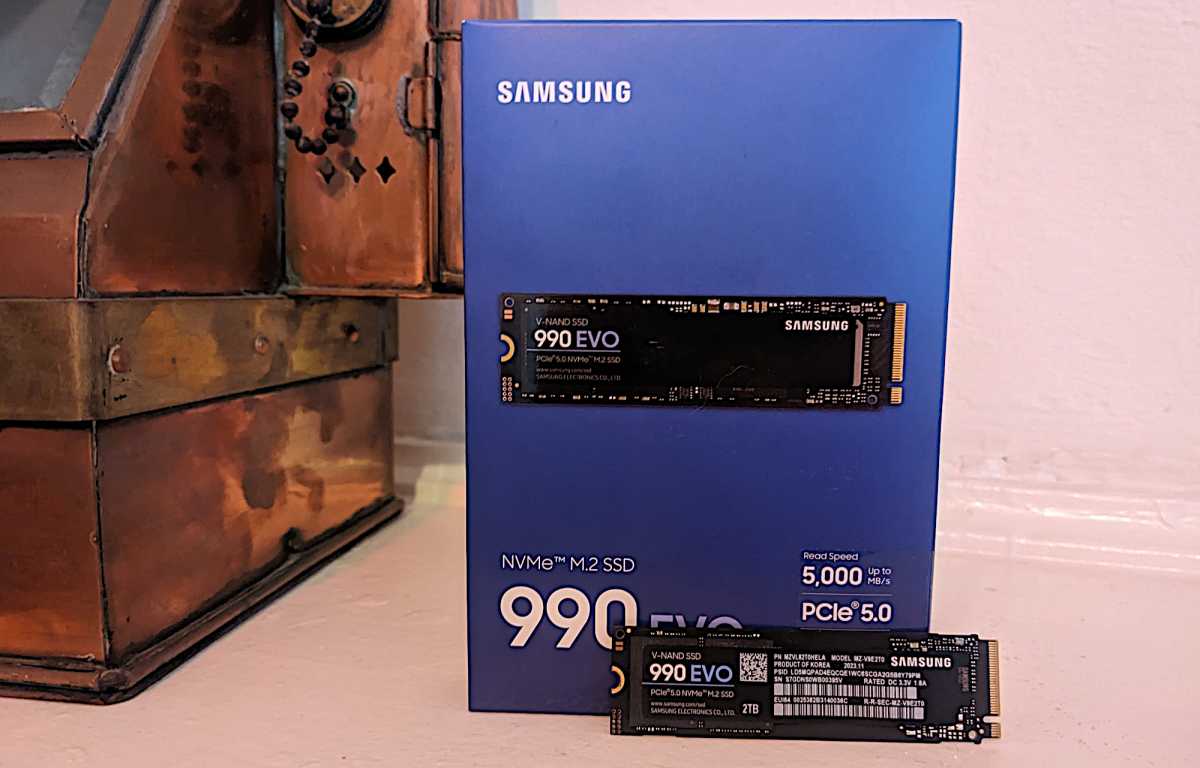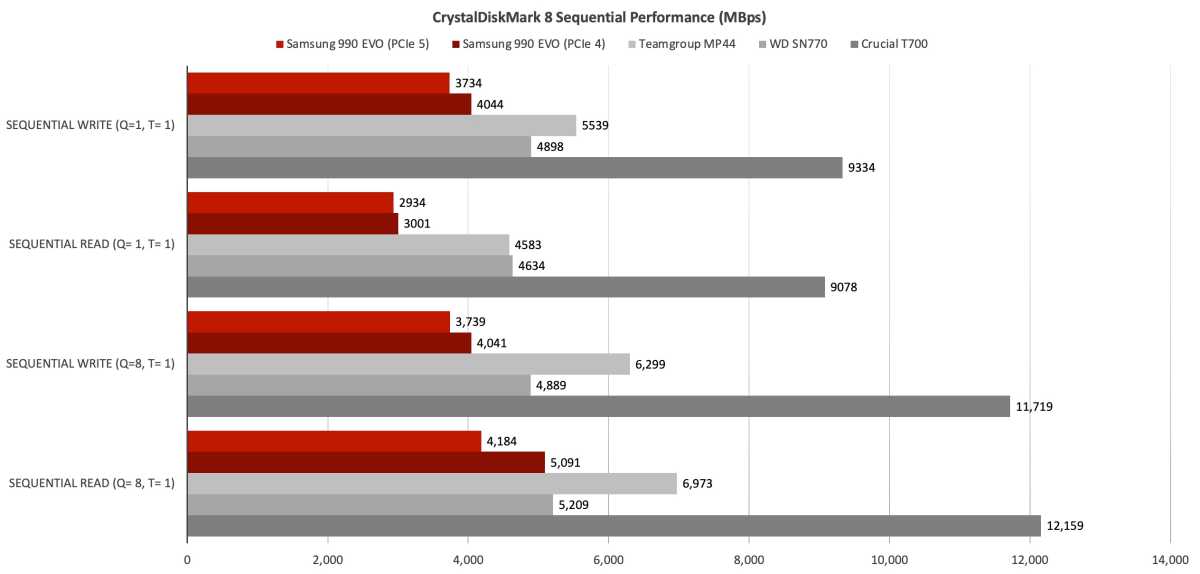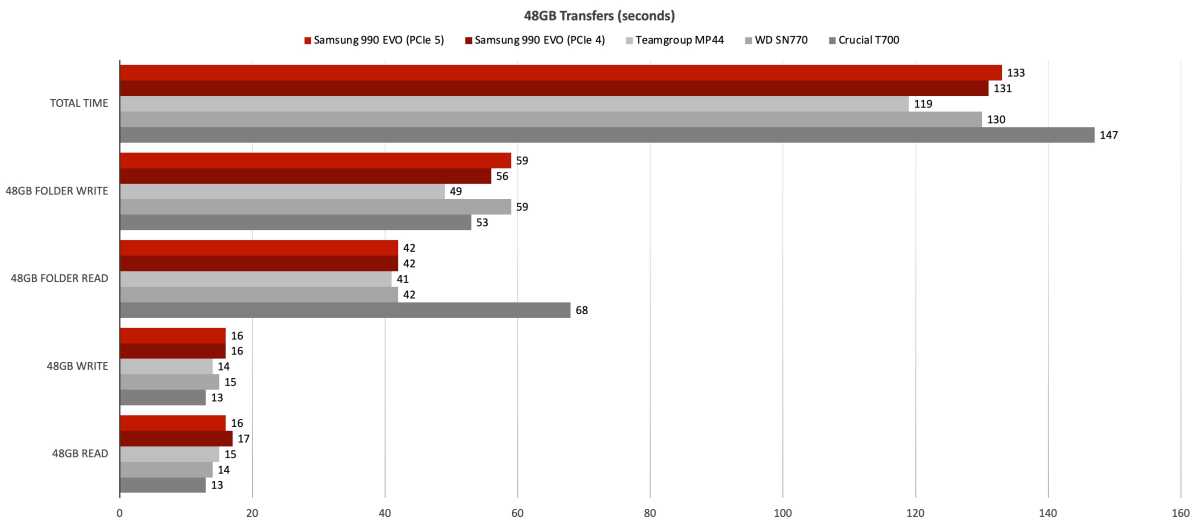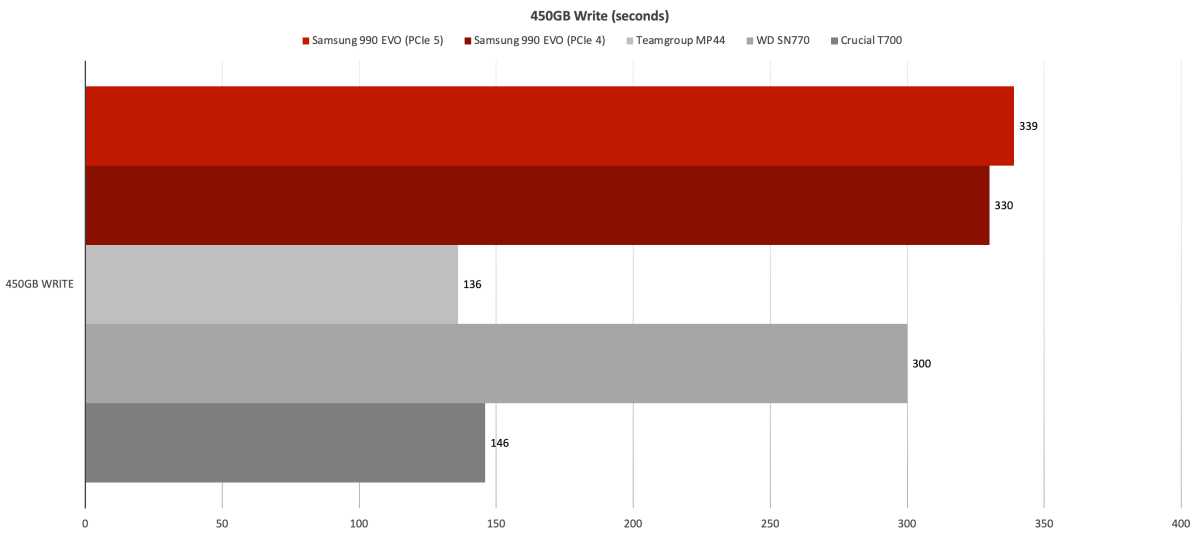
 Image: Samsung
Image: Samsung
At a glance
Expert’s Rating
Pros
Decent performancePCIe 5.0 x2 or PCIe 4.0 x4Five-year warranty and good TBW rating
Cons
PCIe 5.0 performance was inconsistent and slower than PCIe 4.0 performancePricey compared to the bargain PCIe 4.0 competition
Our Verdict
Samsung’s 990 EVO can run at the PCIe 5.0 standard, but it’s constrained to two lanes (x2) and performs strictly like a PCIe 4.0 SSD. A somewhat pricey, and not particularly fast PCIe 4.0 SSD, at that.
Price When Reviewed
1TB: $125 I 2TB: $210
Best Prices Today: Samsung 990 EVO
RetailerPrice
Samsung is first to market with what would appear to be the affordable PCIe 5.0 SSD we’ve all been waiting for — the 990 EVO. Alas, in our testing, with the drive only able to leverage two PCIe 5.0 lanes, it proved slower and less consistent than when using four lanes of PCIe 4.0. Even for PCIe 4.0, it’s not a particularly fast, and on the pricey side.
Further reading: See our roundup of the best SSDs to learn about competing products.
What are the Samsung 990 EVO’s features?
The 990 EVO is a 2280 form factor (22mm wide, 80mm long) NVMe SSD utilizing stacked, 133-layer TLC NAND and an in-house Samsung controller, according to the company.
Unusually, it can function as either a four-lane (x4) PCIe 4.0 (or previous generations at slower speeds), or a two-lane (x2) PCIe 5.0 M.2 SSD, providing the same theoretical bandwidth. With the right BIOS, it could save a couple of precious PCIe 5.0 lanes in that mode. Credit to Samsung for the innovation.
Host Memory Buffer (HMB) is utilized for primary caching so there’s no DRAM on board. Recent vintage HMB has proven equal or better than DRAM-enabled PCIe 4.0 SSDs in sustained transfers, and almost as fast overall as DRAM-endowed PCIe 5.0 designs.
Note that this is the first HMB/PCIe 5.0 SSD we’ve seen or tested.

The 990 EVO is warrantied for five years or 600TBW (terabytes that may be written) per 1TB of capacity. That warranty is par for the course, as is the TBW rating. Hardly Seagate-like, but much better than QLC NAND drives.
How much is the Samsung 990 EVO?
The 990 EVO will ship in 1TB and 2TB flavors for $125 and $210, respectively. That’s the MSRP and nearly twice what you will pay for a bargain HMB PCIe 4.0 NVMe SSD.
For a brand with the cachet and reputation of Samsung, the premium pricing is somewhat understandable. But also know that while the 990 EVO supports PCIe 5.0, it’s no faster than the average PCIe 4.0. As you’ll see below.
How fast is the Samsung 990 EVO?
The 2TB 990 EVO that Samsung sent us proved a decidedly unspectacular performer. It’s by far the slowest PCIe 5.0 SSD we’ve tested, and whether PCIe 5.0 or 4.0 was utilized, it only hit the PCIe 4.0 average. But the main issue was that the PCIe 5.0 CrystalDiskMark 8 numbers were wildly inconsistent across runs — anywhere from 3GBps to 5GBps reading. Normal variation is a couple hundred MBps max.
The inconsistency caused us to throttle our testbed’s PCIe M.2 slots to 4.0 and retest. The CrystalDiskMark 8 and AS SSD 2.0 (not shown) results when using the 990 EVO over PCIe 4.0 were slightly faster to much faster, and entirely consistent across runs — approximately 5GBps reading and 4GBps writing sequentially in CrystalDiskMark.
Quite likely, HMB, at least as implemented on the 990 EVO, likes more pipes, even if they are only half as fast.
Think of the 990 EVO as a slightly pricey, average-performing PCIe 4.0 SSD.

Note that the competing Teamgroup MP44 and WD SN770 are both PCIe 4.0 HMB designs. The Crucial T700 is thrown in to give you an idea of what’s possible with PCIe 5.0 (and DRAM).
The 990 EVO’s 4K performance (shown below) under CrystalDiskMark 8 was far more competitive.

Our real-world sequential 48GB transfer tests were kinder to the 990 EVO than CrystalDiskMark 8 — at least while secondary cache (TLC written as SLC) held out. In fact, it beat out the number one overall Crucial T700 — a drive that had a mysteriously hard time reading smaller files and folders while coming up aces at everything else.

Secondary cache ran out just past the 100GB mark, hence the five minutes plus it took the 990 EVO to write the full 450GB. You can see the actual occurrence in the last image below.

While the 990 EVO writes to secondary cache at over 3GBps, it drops to around 1.15GBps when writing natively to the TLC NAND. That’s actually not that bad considering hard drives manage only 250MBps and SATA SSDs top out at 525MBps. It’s not ideal, but it’s not the tragic-for-NVMe 150MBps you’ll see when some QLC drives run out of secondary cache.

Note that the PCIe 5.0 issues may be related to our testbed and not effect other computers. The entire testbed configuration can be found at the end of the article. The motherboard is an Asus ROG STRIX Z790-i. We paid hard cash for it so we don’t normally give the company free advertising, but in this case the make and model might be relevant.
Should you buy the Samsung 990 EVO?
The 990 EVO was a faster, more consistent performer with four lanes of PCIe 4.0 than with two lanes of PCIe 5.0. Why, we’re not certain; however, forget the PCIe 5.0, innovative as it is, and think of it as a slightly pricey, average-performing PCIe 4.0 SSD and make you decision from there.
Sadly, the bargain PCIe 5.0 SSD remains a chimera.
How we test
Drive tests currently utilize Windows 11 (22H2) 64-bit running on an X790 (PCIe 5.0) motherboard/i5-12400 CPU combo with two Kingston Fury 32GB DDR5 modules (64GB of memory total). Intel integrated graphics are used. The 48GB transfer tests utilize an ImDisk RAM disk taking up 58GB of the 64GB total memory. The 450GB file is transferred from a Samsung 990 Pro 2TB, which also contains the operating system.
Each test is performed on a newly formatted and TRIM’d drive so the results are optimal. Note that as any drive fills up, performance will decrease due to less NAND for secondary caching, and other factors.
The performance numbers shown apply only to the drive we were shipped as well as the capacity tested. SSD performance can vary by capacity due to more or fewer chips to read/write across and the amount of NAND available for secondary caching (writing TLC/QLC as SLC). Vendors also occasionally swap components. If you ever notice a large discrepancy between the performance you experience and that which we report (systems being roughly equal), by all means—let us know.
Best Prices Today: Samsung 990 EVO
RetailerPrice
Author: Jon L. Jacobi, Freelance contributor

Jon Jacobi is a musician, former x86/6800 programmer, and long-time computer enthusiast. He writes reviews on TVs, SSDs, dash cams, remote access software, Bluetooth speakers, and sundry other consumer-tech hardware and software.
Recent stories by Jon L. Jacobi:
SanDisk Desk Drive USB SSD review: High capacity, 10Gbps performanceSK Hynix Tube T31 review: Looks like a USB drive, performs like a SSDTeamgroup Z540 review: A worthy competitor for the SSD performance crown


